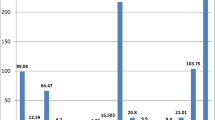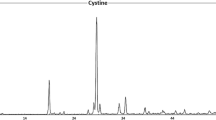Abstract
The role of metals in urinary stone formation has already been studied in several publications. Moreover, urinary calculi can also be used for assessing exposure of humans to minor and trace elements in addition to other biological matrices, for example, blood, urine, or hair. However, using urinary calculi for biomonitoring of trace elements is limited by the association of elements with certain types of minerals. In this work, 614 samples of urinary calculi were subjected to mineralogical and elemental analysis. Inductively coupled plasma mass spectrometry and thermo-oxidation cold vapor atomic absorption spectrometry were used for the determination of major, minor, and trace elements. Infrared spectroscopy was used for mineralogical analysis, and additionally, it was also employed in the calculation of mineralogical composition, based on quantification of major elements and stoichiometry. Results demonstrate the applicability of such an approach in investigating associations of minor and trace elements with mineralogical constituents of stones, especially in low concentrations, where traditional methods of mineralogical analysis are not capable of quantifying mineral content reliably. The main result of this study is the confirmation of association of several elements with struvite (K, Rb) and with calcium phosphate minerals, here calculated as hydroxylapatite (Na, Zn, Sr, Ba, Pb). Phosphates were proved as the most important metal-bearing minerals in urinary calculi. Moreover, a significantly different content was also observed for Fe, Zr, Mo, Cu, Cd, Se, Sn, and Hg in investigated groups of minerals. Examination of such associations is essential, and critical analysis of mineral constituents should precede any comparison of element content among various groups of samples.




Similar content being viewed by others
References
Abboud, I. A. (2008a). Analyzing correlation coefficients of the concentrations of trace elements in urinary stones. Jordan Journal of Earth and Environmental Sciences, 1(2), 73–80.
Abboud, I. A. (2008b). Concentration effect of trace metals in Jordanian patients of urinary calculi. Environmental Geochemistry and Health, 30(1), 11–20.
Abboud, I. A. (2008c). Mineralogy and chemistry of urinary stones: patients from North Jordan. Environmental Geochemistry and Health, 30(5), 445–463.
Atakan, I. H., Kaplan, M., Seren, G., Aktoz, T., Gul, H., & Inci, O. (2007). Serum, urinary and stone zinc, iron, magnesium and copper levels in idiopathic calcium oxalate stone patients. International Urology and Nephrology, 39(2), 351–356.
Bazin, D., Chevallier, P., Matzen, G., Jungers, P., & Daudon, M. (2007). Heavy elements in urinary stones. Urological Research, 35(4), 179–184.
Bazin, D., Daudon, M., Combes, C., & Rey, C. (2012). Characterisation and some physicochemical aspects of pathological microcalcifications. Chemical Reviews, 112(10), 5092–5120.
Chaudhri, M. A., Watling, J., & Khan, F. A. (2007). Spatial distribution of major and trace elements in bladder and kidney stones. Journal of Radioanalytical and Nuclear Chemistry, 271(3), 713–720.
Daudon, M., Bader, C. A., & Jungers, P. (1993). Urinary calculi: review of classification methods and correlations with etiology. Scanning Microscopy, 7(3), 1081–1106.
Daudon, M., Bazin, D., André, G., Jungers, P., Cousson, A., Chevallier, P., et al. (2009). Examination of whewellite kidney stones by scanning electron microscopy and powder neutron diffraction techniques. Journal of Applied Crystallography, 42(1), 109–115.
Daudon, M., Dore, J. C., Jungers, P., & Lacour, B. (2004). Changes in stone composition according to age and gender of patients: a multivariate epidemiological approach. Urological Research, 32(3), 241–247.
Daudon, M., Jungers, P., & Bazin, D. (2008). Peculiar morphology of stones in primary hyperoxaluria. The New England Journal of Medicine, 359(1), 100–102.
Durak, I., Kilic, Z., Sahin, A., & Akpoyraz, M. (1992). Analysis of calcium, iron, copper and zinc contents of nucleus and crust parts of urinary calculi. Urological Research, 20(1), 23–26.
Durak, I., Yasar, A., Yurtarslani, Z., Akpoyraz, M., & Tasman, S. (1988). Analysis of magnesium and trace-elements in urinary calculi by atomic-absorption spectrophotometry. British Journal of Urology, 62(3), 203–205.
Graeser, S., Postl, W., Bojar, H. P., Berlepsch, P., Armbruster, T., Raber, T., et al. (2008). Struvite-(K), KMgPO(4)·6H(2)O, the potassium equivalent of struvite—a new mineral. European Journal of Mineralogy, 20(4), 629–633.
Hesse, A., & Sanders, G. (1988). Atlas of infrared spectra for the analysis of urinary concrements. Stuttgart: Thieme Publishing Group.
Horbarth, K., Koeberl, C., & Hofbauer, J. (1993). Rare-earth elements in urinary calculi. Urological Research, 21(4), 261–264.
Kuta, J., Machát, J., Benová, D., Červenka, R., & Kořistková, T. (2012). Urinary calculi—atypical source of information on mercury in human biomonitoring. Central European Journal of Chemistry, 10(5), 1475–1483.
Martinec, P., Plasgura, P., Machát, J., & Staněk, F. (2011). Mineral association, composition and trace elements in urinary calculi in Ostrava 1978–2010. European Urology, 10(7), 462.
Moroz, T. N., Palchik, N. A., & Dar’in, A. V. (2009). Microelemental and mineral compositions of pathogenic biomineral concrements: SRXFA, X-ray powder diffraction and vibrational spectroscopy data. Nuclear Instruments & Methods in Physics Research Section a-Accelerators Spectrometers Detectors and Associated Equipment, 603(1–2), 141–143.
Perk, H., Serel, T. A., Kosar, A., Deniz, N., & Sayin, A. (2002). Analysis of the trace element contents of inner nucleus and outer crust parts of urinary calculi. Urologia Internationalis, 68(4), 286–290.
Pineda-Vargas, C. A., Eisa, M. E. M., & Rodgers, A. L. (2009). Characterization of human kidney stones using micro-PIXE and RBS: A comparative study between two different populations. Applied Radiation and Isotopes, 67(3), 464–469.
Pineda-Vargas, C. A., Rodgers, A. L., & Eisa, M. E. (2004). Nuclear microscopy of human kidney stones, comparison between two population groups. Radiation Physics and Chemistry, 71(3–4), 947–950.
Shad, M. A., Ansari, T. M., Afzal, U., Kauser, S., Rafigue, M., & Khan, M. I. (2001). Major constituents, free amino acids and metal levels in renal calculi from multan region. Online Journal of Biological Sciences, 1(11), 1063–1065.
Shannon, R. D., & Prewitt, C. T. (1969). Effective ionic radii in oxides and fluorides. Acta Crystallographica Section B, 25(5), 925–946.
Slojewski, M. (2011). Major and trace elements in lithogenesis. Central European Journal of Urology, 64(2), 58–61.
Slojewski, M., Czerny, B., Safranow, K., Drozdzik, M., Pawlik, A., Jakubowska, K., et al. (2009). Does smoking have any effect on urinary stone composition and the distribution of trace elements in urine and stones? Urological Research, 37(6), 317–322.
Slojewski, M., Czerny, B., Safranow, K., Jakubowska, K., Olszewska, M., Pawlik, A., et al. (2010). Microelements in stones, urine, and hair of stone formers: A new key to the puzzle of lithogenesis? Biological Trace Element Research, 137(3), 301–316.
Touryan, L. A., Lochhead, M. J., Marquardt, B. J., & Vogel, V. (2004). Sequential switch of biomineral crystal morphology using trivalent ions. Nature Materials, 3(4), 239–243.
Wandt, M. A. E., & Underhill, L. G. (1988). Covariance Biplot analysis of trace-element concentrations in urinary stones. British Journal of Urology, 61(6), 474–481.
Acknowledgments
This work was supported by The Czech Science Foundation (GA203/09/1394) and CETOCOEN (ED0001/01/01) project granted by the European Union and administered by the Ministry of Education, Youth and Sports of The Czech Republic.
Author information
Authors and Affiliations
Corresponding author
Rights and permissions
About this article
Cite this article
Kuta, J., Machát, J., Benová, D. et al. Association of minor and trace elements with mineralogical constituents of urinary stones: A hard nut to crack in existing studies of urolithiasis. Environ Geochem Health 35, 511–522 (2013). https://doi.org/10.1007/s10653-013-9511-5
Received:
Accepted:
Published:
Issue Date:
DOI: https://doi.org/10.1007/s10653-013-9511-5




